Traditional and most commonly used is water heating
Tell me, what do you associate with the word "coziness"? Surely, the overwhelming majority have warmth. Especially in a country with a cold climate, snowy winters and fierce frosts. Therefore, the main system, important not only for a comfortable life, but for survival, of course, is the heating system. Of the many variants of its variants, the most widespread is that in which the role of the coolant is played by water.
Features of water heating
To solve the problem of heat transfer from a source to heated rooms have been tried for a long time. But the use of special channels for this purpose with air as a coolant resulted in large heat losses.
In the middle of the nineteenth century, steam heating appeared. And soon it was replaced by water. The use of water in heating systems has made it possible to reduce the temperature of the coolant in comparison with steam systems. Therefore, heating has become much safer, and the cost of heating is less.
With the advent of new thermal insulation materials and technologies, it became possible to transfer heat over long distances. Thus, central heating systems for neighborhoods, districts and entire cities were built.
Heating of water in them occurs in large heaters, after which it is transferred to houses through external pipelines. But completely to exclude heat losses in such complexes it is impossible, therefore recently autonomous systems became popular.
The centralized system has one more drawback. It does not allow you to make a water-heated floor from central heating. This is due to technological difficulties and administrative prohibitions. So this option is possible only due to electric heating systems. With centralized heating everything is clear. And what is an autonomous system?
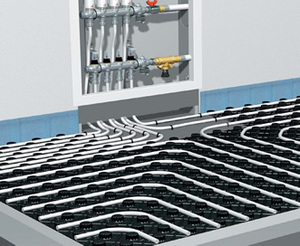
Two-pipe water heating system is the most common
The main feature of such systems is the absence of external communications for heat transfer and, accordingly, the absence of its losses. An autonomous heater is installed in the house, and fuel is delivered by transport or transmitted to the house via special highways. The optimal fuel for such systems is natural gas. In addition, it can use fuel oil, coal, wood and its processing products.
To ensure the smooth operation of such systems, water and electricity must be connected to the house. Internal communications of premises with independent heating are no different from those connected to central heating - the same pipes and the same batteries. Losses in autonomous heating systems are minimized and are more dependent on heating equipment and fuel type.
Composition of the heating complex, equipment and materials
The structure of any heating system includes:
- heater
- heat transfer lines
- heating devices
Let us consider this scheme in more detail. And for example, let's take a complex based on a gas boiler. As a fuel, it uses natural gas from a conventional gas supply system. In the gas boiler, the water is heated to a certain temperature, after which this water is transported through the pipes to the heating devices - radiators (batteries).
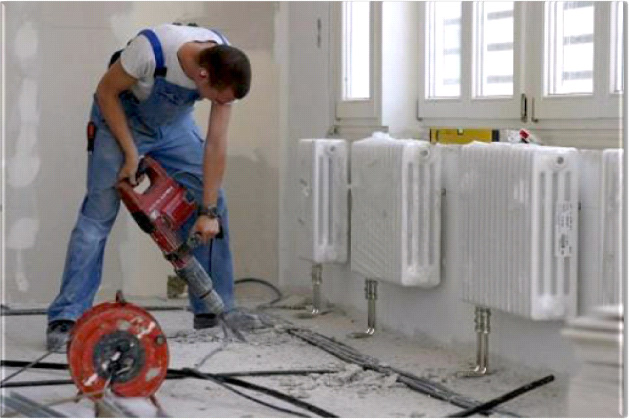
Installation of battery and pipes
Along with traditional iron, plastic pipes have also become widely used. Due to this, installation of pipelines has become easier and cheaper, and their durability in a humid environment is much higher.
The efficiency of heating in such a system depends directly on the heating devices and the way they are installed. And along with traditional batteries, the use of floor heating is increasingly used.
Here, let's take a closer look at this method of heating the room.
How is the heating of the floors?
Disputes about the advantages and disadvantages of such heating do not cease from the moment of its appearance. But one thing is certain - floor water heating - a warm floor - can create a comfortable and cozy atmosphere at any point of the room. After all, the farther from the battery, the cooler. And if a person's feet are warm, then he feels much more comfortable.
And further. Due to what is the room heated from the radiator? Due to the convection of air. Cold flow passes through the battery and already warms up narrow stripe - usually along a wall or a window. So it turns out that the warmest zone is above the battery. And when the floor is heated, it is constantly under your feet.

Underfloor heating
When installing the underfloor heating system, radiators, heat exchangers and other special devices are not needed. The role of the radiator is played by pipes for water heating, laid in the floor. They can be metal or metal plastic. The main thing is that they have good heat transfer.
Polypropylene pipes for such systems are not suitable, because they have low heat transfer, poorly transmit heat to surrounding objects and therefore can not heat the floor material.
Heating pipes are connected to a common heating system as self-contained circuit with an entrance, an exit and an adjusting crane. Thus, to be more precise, its operation can be regulated independently of other elements of the system.
Selection of heating zones
When installing a warm floor it does not make sense to heat the surface under furniture, a fireplace, a built-in wardrobe and other furnishings. After all, the hosts will not go there.
Therefore, it is more logical and economical to install heating only in places where people are constantly or often:
- For the kitchen this is practically the whole area, except for a place under furniture and household appliances.
- For a bathroom - approaches to a bath and a shower cabin, and the rest - at will.
- For living quarters, everything is very individual, but the area around the armchairs, beds and tables should be heated.
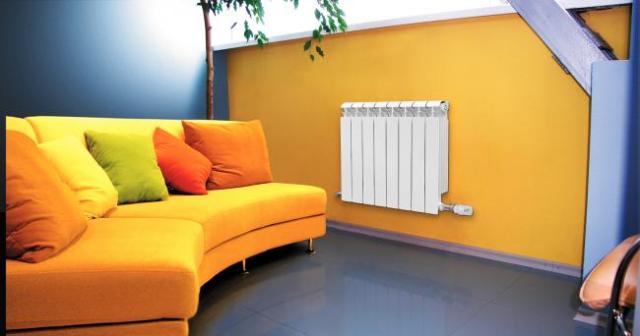
Selection of heating zones
Do not put the water floor heating close to the walls and doorways.
And one more restriction. Do not try to warm the wood or parquet floor. On them the heating is not effective, and the parquet floor can also dry up.
Pipe laying
Having determined the heating zones, you can start working. Let's consider it on an example of metal-plastic pipes. They are delivered in coils of 100 meters, which allows you to lay the pipe without unnecessary elements of docking. For our purposes, pipes with an external diameter of 16 mm will be needed.
First, heat-reflecting screens are placed on the screed, and pipes are directly on them. Pipe laying in each area is performed by a zigzag with parallel lines or a spiral of parallel lines. Inputs and outputs of all areas should be reduced to one point - it will be easier then to connect them to the common system.
If the house has a basement and it is not heated, then before laying the heat-reflecting screens it is necessary to lay a layer of heat-insulating material throughout the entire area of the room, regardless of the heating zone. After installation of pipes it is possible to start a finishing screed and a floor covering. In this case, the thickness of the screed should not exceed 100 mm.
This scheme does not exclude the use of classical radiators. Wall mounted or connected to a separate circuit. This allows more efficient use of the entire heating system, depending on the conditions or wishes of the owners.
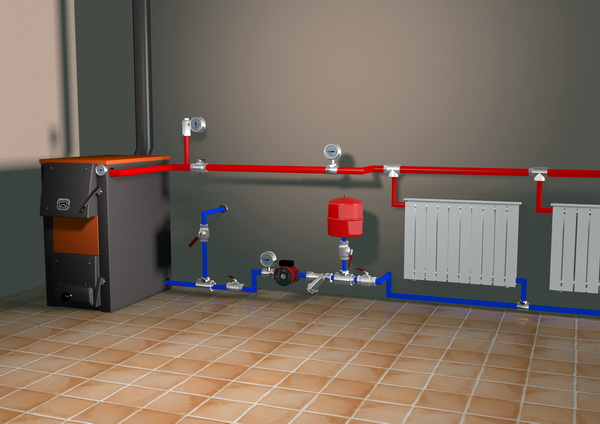
Scheme for connecting a solid fuel heating boiler
All separate lines start and end in one place. It is here that you need to equip a certain control point. It can be located under the stairs, in the pantry or near the boiler itself.
Collected in one place the ends of the pipes of the warm floor are connected to the common system. For ease of adjustment and control, it will not be superfluous to immediately install a temperature and pressure gauge, adjusting valves, and if necessary, a retaining pump. Especially convenient is an intermediate control panel in private houses with two or more floors.
Some conclusions
When deciding on the choice of a heating system for a house or apartment, remember that the water heating in the floor can not be tied to central heating. In this case, only electric heating can be used.
The floor heating can be connected to any heating boiler in which water is used as a coolant. Electric and solid fuel boilers are no exception.
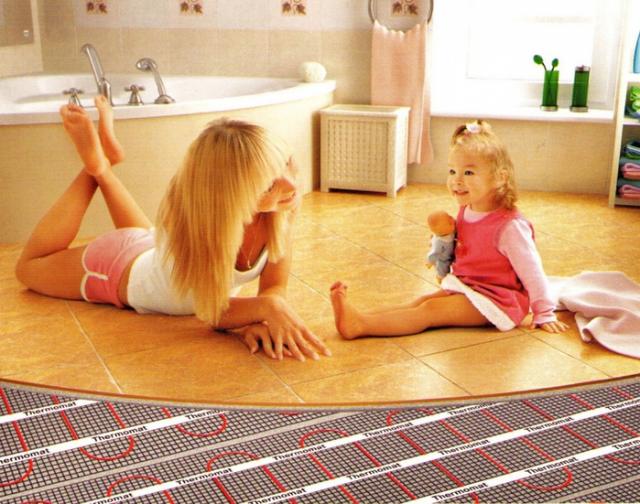
Floor heating can be connected to any heating boiler
If desired, heat small area apartments, for example, only a section of the floor in the bathroom, it is also better to install electric, rather than water heating.
The most effective pipes for heating in the floor are copper - because of their good heat transfer. But the features of welding and the high cost of the metal itself do not allow using them all over the place. Metalloplastikovye and polyethylene pipes proved to be very good for these purposes.
The most effective water floor heating will be where there is ceramic tile, linoleum or carpet. Wooden, parquet floors, and also the floor from the laminated panels have low thermal conductivity, therefore their heating is ineffective.
Before the beginning of the autumn-winter season it is worth considering that comfort and comfort in the house is impossible without a source of heat. Unfortunately, the heating system, which is not always used, sufficiently warms the room throughout the whole area and, with the onset of cold weather, discomfort begins because of the cold entering the house. Traditional heaters and fan heaters are replaced by modern built-in heating systems.
The operating principle of the water-heated floor system
A water-heated floor is a new independent system of premises heating, A modern alternative to common radiator and convection heating types. The device of a water-heated floor is a network of installed pipelines filled with hot water, between a concrete or wooden base and a floor covering.
 The water floor consists of polymer pipes, through which a warm liquid is circulated from the central heating system or gas boiler. From the heated surface of the floor, the air warms up and rushes upwards, ensuring an even distribution of heat throughout the area. At the same time, the lower layer of air at the floor warms up more than the upper one - at the ceiling, creating the ideal conditions for a comfortable living.
The water floor consists of polymer pipes, through which a warm liquid is circulated from the central heating system or gas boiler. From the heated surface of the floor, the air warms up and rushes upwards, ensuring an even distribution of heat throughout the area. At the same time, the lower layer of air at the floor warms up more than the upper one - at the ceiling, creating the ideal conditions for a comfortable living.
It should be noted that it is possible to equip the water-heated floor with in private homes. For urban apartments, this kind of heat supply is prohibited due to the possible consequences of pipe damage.
Advantages and disadvantages of the water-heated floor
The system of water-heated floor has a number of indisputable advantages, in comparison with radiator and convector heating systems:
- Cost-effective. Reduction of power consumption by 20-30% in residential buildings due to the low temperature of the coolant (30-50 ° C). When installing the water floor in rooms with a large area and high ceiling, the savings on heating is up to 60% due to the warming up of air only 2-2.5 m from the floor level.
- Comfort. Uniform heating of the room from the floor throughout the area allows creating the optimal temperature conditions for human health (+ 22 ° C at the foot level and +18 ° C at the head level). By warm floor nice to walk barefoot, comfortable to play with children.
- Security. Hidden from access heating elements make the space safe even for small children, eliminates the risk of injury or burns from contact with heat carriers.
- Aesthetics of the interior. The lack of visible parts of heating systems and devices facilitates the facilitation of the implementation of redevelopment and design projects. No interference in the form of radiators, which in the case of inconsistent appearance with the concept of the interior should be hidden behind the decorative panels or completely changed to new ones.
Along with the advantages of water, the warm floor has its own characteristics shortcomings:
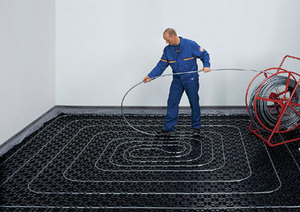
Established in compliance with all technological requirements and safety standards, a warm water floor serves as an optimal additional source of heat in the room.
Installation of a water-heated floor
Before you start installing the system of a warm water floor, you must carefully prepare the surface. Should take out the trashand to make the base leveling, significant differences in the height of the horizontal plane should not be (no more than 5 mm).
There are 3 options for installing a water floor:
Concrete system
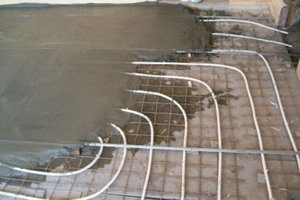 The most common form of laying, in which the base and the distribution layer are used cement-sand screed
. On a pre-aligned concrete surface a layer of waterproofing covering is laid on which a layer of thermal insulation is laid on top. Then the heating pipes are laid and fixed. For large areas, reinforcing mesh is additionally used for laying pipes. If the area is small, it will be sufficient to fasten the pipes over the insulation with special plastic clips, fixing slats or dowel hooks.
The most common form of laying, in which the base and the distribution layer are used cement-sand screed
. On a pre-aligned concrete surface a layer of waterproofing covering is laid on which a layer of thermal insulation is laid on top. Then the heating pipes are laid and fixed. For large areas, reinforcing mesh is additionally used for laying pipes. If the area is small, it will be sufficient to fasten the pipes over the insulation with special plastic clips, fixing slats or dowel hooks.
Further, a carrier layer is inserted, which is a sand-cement mixture supplemented by plasticizer. The final stage is laying floor covering over the heating system. As the top layer of the warm floor is ideal ceramic tile, decorative stone, laminated parquet.
Polystyrene system
 An easier-to-install design is based on the use of special heat-insulating polystyrene plates. The shape of the board is in the form of convex circles of small diameter designed for easy and quick laying of pipes. The slabs at the edges have locks for reliable adhesion to each other and allow the creation of a monolithic insulating shield throughout the floor surface.
An easier-to-install design is based on the use of special heat-insulating polystyrene plates. The shape of the board is in the form of convex circles of small diameter designed for easy and quick laying of pipes. The slabs at the edges have locks for reliable adhesion to each other and allow the creation of a monolithic insulating shield throughout the floor surface.
The laying of heating pipes on the basis of polystyrene plates does not require the application fasteners. Installation is made by pressing and fixing a piece of pipe in the grooves between the protuberances of the plate. The next layer is laid metal heat distribution plate. Then a clean floor covering is installed
Wooden system
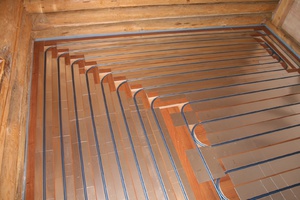 AT wooden system The supporting layer for the pipes is an edging board, a wood board, plywood , MDF, etc. Wooden slabs are spread on narrow strips 130-180mm and with intervals under pipes lay on the basis (a wooden floor or lags). Screws are fixed to the top with special thermo-distributing plates with omega-shaped grooves under the heating pipes. The grooves of the metal plates fall into the notches between the wood plates. The heating pipe is fixed in omega-shaped grooves without the use of fasteners.
AT wooden system The supporting layer for the pipes is an edging board, a wood board, plywood , MDF, etc. Wooden slabs are spread on narrow strips 130-180mm and with intervals under pipes lay on the basis (a wooden floor or lags). Screws are fixed to the top with special thermo-distributing plates with omega-shaped grooves under the heating pipes. The grooves of the metal plates fall into the notches between the wood plates. The heating pipe is fixed in omega-shaped grooves without the use of fasteners.
After laying the pipes, the entire surface is covered with a polyethylene film. Then fix with self-tapping screws sheets GVL, serving as a thermal distribution layer and the basis for finishing the floor.
For the distribution of the coolant through the heating circuits distribution manifold.The supply and return pipes are connected to the manifold. To the supply pipe with hot water, a distribution manifold is installed, and the collector for the cooled coolant is connected to a return pipe.
Features of the operation of the water-heated floor
Connect the water-heated floor as soon as the first cold days begin. Heating of the premises can take enough time. After all, the floor is completely warmed up first, then the walls, and only after that the air is heated and a constant temperature is set.
If the surface of a warm water floor is covered with a laminate or wood, the temperature of the circulating liquid is recommended to be increased gradually. This approach will extend the life of the coating.
If necessary, it is possible to heat the room with a warm water floor all year round. In summer, it is necessary to separately connect the heating ceramic tiles, which is cold even in the heat.
Floor heating thanks to a large heat transfer surface provides a healthy - from bottom to top and even distribution of heat in the room. The main advantage of a water-heated floor is safety and durability.
The modern approach to heating contributes to creating an atmosphere of comfort and coziness in the house.
If we have not done heating systems with a warm water floor before, it will not be right to undertake immediately the practical embodiment of our desires. We must first pay attention to some theory. Well, at least learn about the pros and cons of warm floors. Perhaps, the disadvantages will be such that you do not want to have such a heating system in your house at all.
What are the advantages of having water warm floors in comparison with radiators?
Minuses of water-heated floor
- The heat loss of the room where the floor is installed must be less than 100 W / m2.
Conclusion: at higher heat losses, either warm the house , or mount combined heating (water-heated floor plus radiators).
- It is not always possible to mount a water-heated floor in apartment buildings, where single-pipe heating systems. Well, or at least you need to know how to make this connection correctly and without any conflicts either with neighbors or with public utilities (this is described in detail in the article about installation of a warm water floor in the apartment).
- Large thickness of concrete screed above the warm floor. If such heating is on the second floor or higher, then the floor level will rise by ~ 10 cm. On the first floor or on the ground floor, there is more - by 14-20 cm. In other words, by preparing in the old apartment (house) a warm water floor, get ready to other global works related to the reinstallation of doors. And yet: the concrete screed of the warm floor will increase the load on the floors and other structures ... are you sure that they will withstand? What is your confidence on? Think about it.
- Installation of a water-heated floor and materials for it is more expensive than for radiator heating. However, these expenses then pay for themselves at the expense of saving energy resources, as I wrote above.
There are a few minuses of warm floors, which must be taken into account necessarily. I will list them.
- Any warm floor (not necessarily water) is not the best heating system for rooms in which people are constantly. Are you surprised? I'll explain why. Alas, almost everything in the world has a downside.
- I did not mention the absence of mixing of air layers in the pluses of the warm floor. But this is also a minus, because you can not make normal natural ventilation. But with the radiators natural ventilation is possible.
Conclusion: designing the warm floors, design and forced ventilation with all its "charms" (snap to the power grid, noise, additional waste ... this is you in the continuation of the topic of profitability), otherwise the air in such a room will be stale.
- Not every material can cover the warm floor. Therefore, you need to know the following.
It is necessary to distinguish two concepts, similar in sound, but different in meaning: "comfortable floor" and "warm floor". What is the difference?
What is the difference?
The comfortable floor has a temperature of 20 ... 22 degrees and is suitable only for the off-season. But in real winter cold with heating can not cope. And then you need additional heating (radiator, air or even what). To cover a comfortable floor, the tree is quite suitable.
But in warm floor The coolant is heated to 55 ° C. And you can not cover such a floor with a tree! The wood from the heat will crack. But if you do not heat, then, again, in a frost such a heating system can not cope.
And although about the coverings for the warm floor there is a hotel room, I'll say a few words here. As coatings for the warm floor, you need to take only natural materials: carpet from natural material, ceramic, linoleum - also from something natural, not from PVC, parquet and parquet board, etc.). Non-natural materials contain different harmful substances, which when heated will evaporate ... however, they evaporate and without heating. Do you want it?
So, contrary to all the same well-known proverb (or proverb? - I do not remember what the difference is), legs do not always need to be kept warm. I mean, not all the time! To the heated parts of the body, blood flows, it is well known to all. And the feet, being warm all the time, do not rest, the veins do not rest ... The result is a disease of veins because of their constant widening.
Conclusion: to stay in a room with a warm floor you need a limited time. That is, do such heating in the hallway, bathroom, in any passage corridor, in the bathhouse, in the dressing room ... where you are rarely or not for long.
Well, I suppose, now, knowing all the pros and cons of the water-heated floor, you can make a conscious choice, and not "because everything." Next, consider the question energy saving with heating with a warm floor.
heated floor heating
2013-2017. Copyright © Use of the materials of the site is allowed with reference to
One of the drawbacks of classical heating is the appearance of radiators. They will not always look harmonious in the room, and occupy a useful space. Therefore, in some cases, it is preferable to install other heat-supply devices. To make rational and practical floor heating in an apartment and a house it is possible with the help of certain schemes, pipes and convectors.
Advantages and disadvantages of underfloor heating
This water heating of the floor in the apartment is different from the standard design and methods of mounting radiators. Their heating surface is located below the level of the finishing floor. For convection of air flows, the upper plane of the heat supply device has a grating.
All hot water mains are also hidden under the floor. In fact, the user only sees the top grille. Through it, air is heated. There are also differences in the design.
The heating convector in the floor has an oblong shape. Tubes, through which the coolant flows, are connected to the body by means of heat exchanger plates. Most often they are made of copper.
Paul should have the following advantages with his own hands:
- Minimum space occupied. Unlike batteries, the entire volume of the room remains free;
- Creating a thermal air curtain. To reduce heat losses, floor water heating in the house is equipped with window structures and exterior walls. Radiators heat the air in places of the lowest temperatures;
- Good appearance. In fact, water heating floors in a private house will look harmonious in any interior.
The drawbacks include the uneven distribution of heat. Such systems are not recommended for installation in rooms with a large area. To achieve the optimum effect, a heating radiator built into the floor must have a fan to increase air convection. This affects the overall background noise. It is mandatory to install thermostats and programmers to automatically monitor the operation of the system.
Analyzing the feedback on the floor, it can be concluded that it is a source of dust concentration. Therefore for this type of heat supply it is necessary to conduct more frequent wet cleaning.
Types of floor convectors
At the first stage of designing it is necessary to select correctly a radiator of the heating, built in a floor. They differ not only in the standard power characteristics, but also in the design. Material of manufacture is also very important.
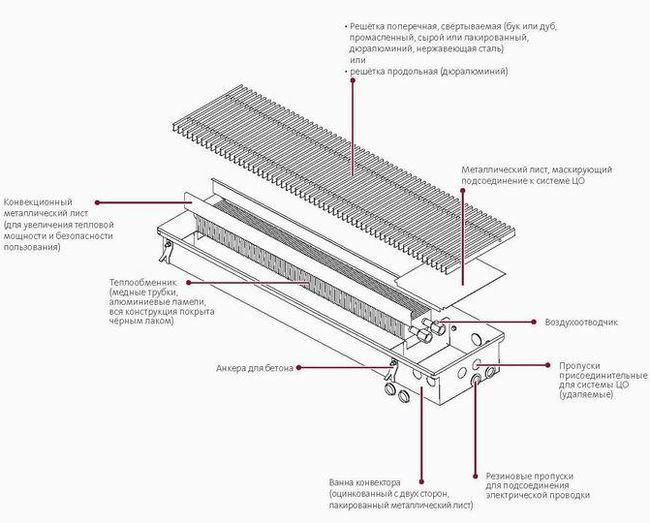
First, the required power is calculated. Based on the thermal losses in the house or apartment. Then the optimal model of the convector of heating in the floor is selected.
It must have the required performance characteristics - to withstand the nominal pressure and temperature of the hot water.
For the installation it will be necessary to do the preparatory work with the rough surface. Efficient heating in the floor with your hands is done only after warming the rough surface.
The choice of the wiring diagram largely depends on the design of the floor radiators. They come in the following forms:
- Napolnye. They are located directly on the surface. Advantage is the simple connection of the water-heated floor to the heating system. Pipes can be located on top of the wall. The disadvantage is the unsatisfactory appearance;
- Built-in. They are mounted directly on the floor on the rough surface. In the visible region, only the lattice remains. The installation of heating in the floor is complicated, since this leads not only to a reduction in the height of the room, but also to the mandatory adaptation of the materials used to high temperatures.
Schemes of floor water heating in an apartment with wall models are not considered. They are no different from the standard ones and have the same properties.
To increase the degree of convection, a fan can be included in the package. This will improve the uniform thermal distribution throughout the room. However, the cost of these models is different in the big direction.
Currently, there are a number of manufacturers whose products are suitable for water heating the floor with their own hands. First of all, it is necessary to distinguish the convectors of the German company Kampmann. Depending on the required parameters, models of heating convectors built into the floor can have two or three pipes. In the latter case, the nominal power of the device increases.
Equally good operating properties are models of heating radiators built into the floor, from the Polish company Verano, the Czech Minib and the German Kermi. For the organization of budget heating in the floor with their own hands, one can consider the products of the Ukrainian company Teplobrend and Carrera.
An additional function of water heating floors in a private home can be cooling in the summer. To do this, you need to connect to the system chiller.
Heating floor schemes
Choosing the optimal model of the heating radiator built into the floor, you can begin to compose a scheme for its installation. At this stage it is important to take into account its operational and technical features.
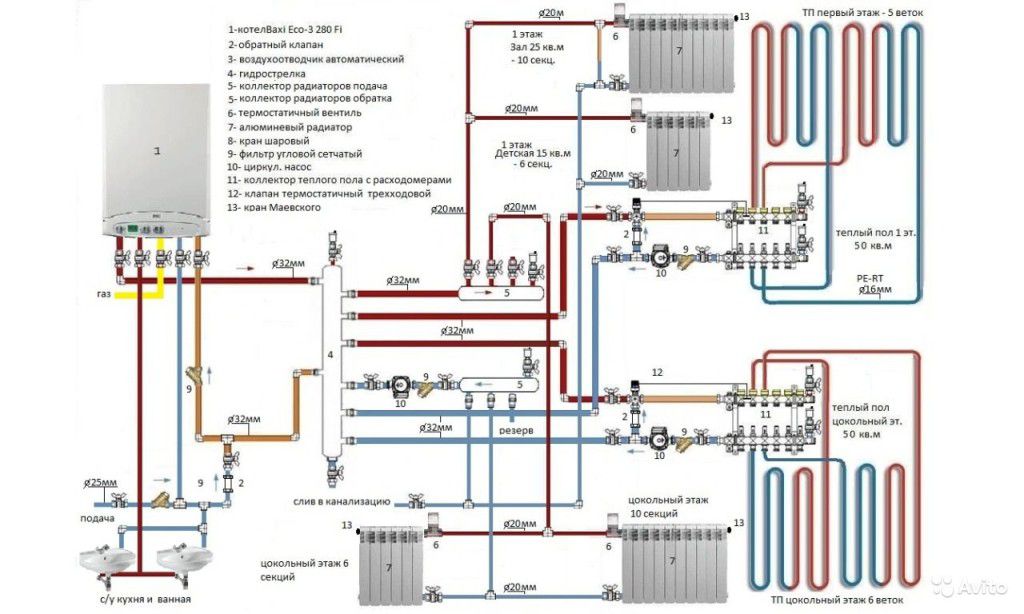
Heating schemes for laying heating in the floor are practically the same as standard ones. The difference lies in the choice of the method of installing pipes and radiators. They must be hidden under the floor. Therefore, it is necessary to choose the material for the floor in advance - a heater, a substrate and a decorative surface.
When choosing a scheme, the following factors are taken into account:
- Height of heat convectors, which will be built into the floor;
- Pipe material. Polymer should not be installed in a concrete screed. Their thermal expansion can tell on the integrity of the highway. For installation, special sleeves are required;
- Inspection hatches. After connecting the hot water floor to the heating system, free access to the piping sites is ensured. This is necessary for repair and maintenance work;
- Installation of air valves, Maevsky cranes and temperature controllers. The most difficult to provide access to these elements of heat supply. The scheme of water heating of floors in a private house should take this factor into account.
Most often, the choice is limited to a closed two-pipe heat supply. It will provide a normal temperature distribution and is the most optimal from the point of view of the laboriousness of installation and selection of components.
To connect the copper nipples of heating radiators built into the floor, with polymer pipes you need special adapters. Copper contact with other metals can lead to oxidation of the joint site.
Installation of floor heating convectors
The correct installation of duct convectors is preceded by preparatory work with a floor. It is necessary to make a niche where the heating devices will be installed. It is best to do this at the repair stage.
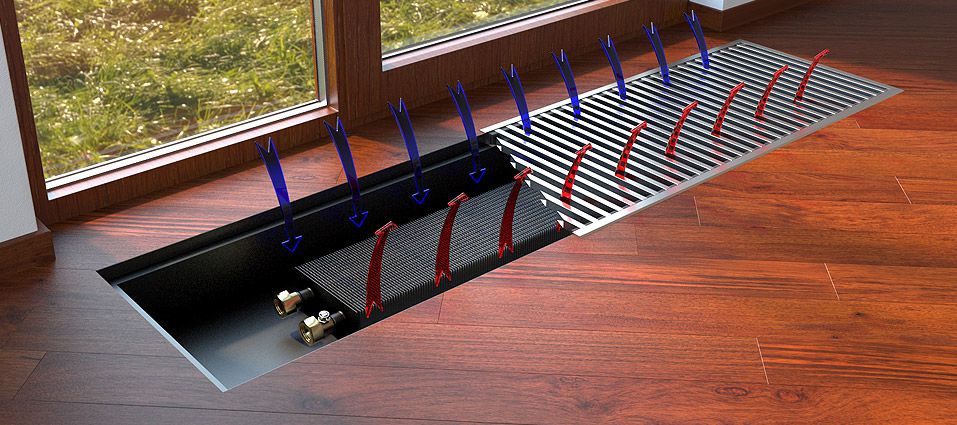
The dimensions of the niche must be larger than the dimensions of the heating device by 5-10 cm. This is necessary for the normal connection of the heat sink after installing it in the floor. Additionally, a layer of thermal insulation is installed. To protect the decorative surface it is recommended to form a niche by the method of concrete pouring.
At this stage, it is necessary to install pipes to further connect to the radiator. Their installation is performed in the floor, the possible temperature expansion is taken into account. For extended sections of the main line, it is necessary to install compensating thermal loops.
The following stages of installation are as follows.
- Installation of heat reflecting material. This will help improve convection and reduce heat loss.
- Installing the heat convection tray in the floor. If there is none, a substrate of heat-resistant material is arranged. The radiator must not hang.
- Connection of nozzles to the heating system. It is important to select the correct couplings to ensure a reliable and durable connection.
- Installation of a decorative lattice.
After the final installation of heating in the floor is a trial run of the system. Preliminary it is necessary to carry out its crimping. Increase the temperature of the coolant should be gradual. The same applies to pressure. At this stage, the absence of leaks in the water heat supply of the floor by oneself is controlled, the operating modes of the thermostats are set.
One of the most common errors in the installation of convectors without a pallet is the filling of a niche with construction foam. Its pressure can lead to deformation of the structure.
Features of the operation of underfloor heating
Before each heating season, it is necessary to check the integrity of the system components. Virtually all of the reviews on heating in the floor indicate a large amount of dust and dirt in the niches. They should be cleaned periodically.
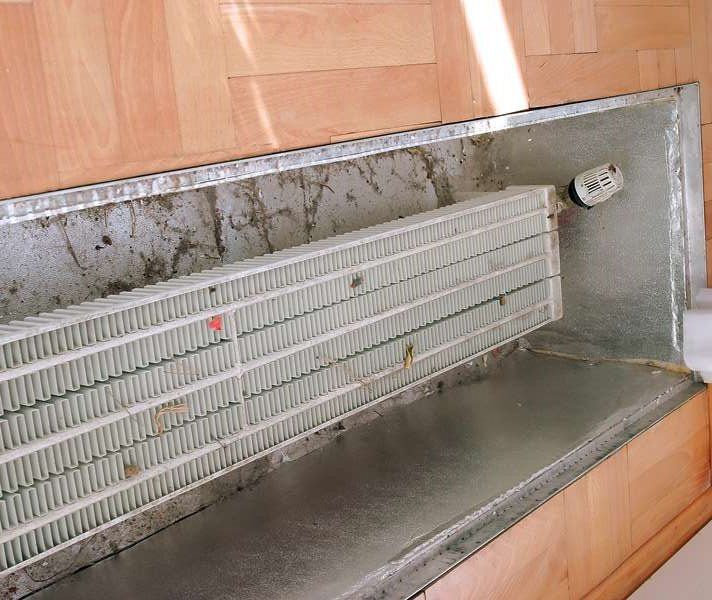
During operation, the parameters of the thermostat can change. Since it will be hidden behind the decorative grid - it is necessary to check its condition. Otherwise, the probability of incorrect operation of the system will increase. In addition, the integrity of the connection of the water-heated floor to the heating system is monitored. In such schemes it is difficult to control the appearance of leaks.
In models with a fan, the power line is laid in advance. To improve comfort, it is recommended to make a remote switch. Also, the rotor of the fan is often clogged. It must be cleaned before each heating season.
In the video of the show, an example of installing a duct convector in an apartment:
Heat is one of the most important conditions of comfort in winter, without which it is impossible to create a feeling of coziness and well-being. If the room is cold, then you can not avoid colds and other health problems. Fortunately, in most cases, living conditions in private houses and apartments are at the level of the subsistence minimum, which allows to resist frost in the street.
However, even in spite of the presence of central heating, it often happens that the room is still not warm enough for a comfortable state of health. Here, additional sources of heating come to the rescue, among which the most preferable is floor water heating.
Characteristics of the heating system
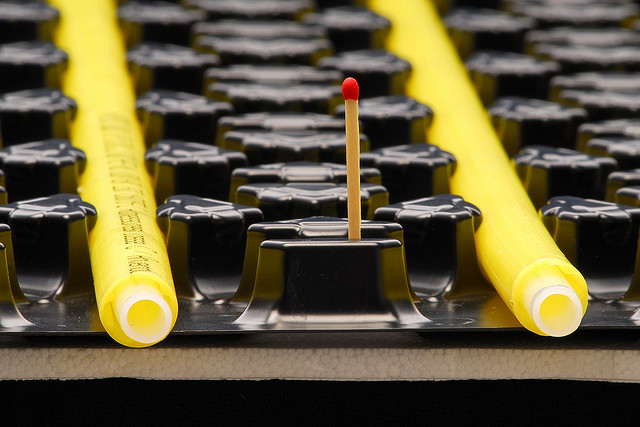
Heating water floor consists of a system of pipes that are mounted in the core of the floor covering, thereby creating the effect of a "warm floor". The basis of the system consists of pipes made of metal-plastic or polypropylene and a cabinet with distribution manifolds, through which the supply and return of the coolant are carried out.
pros
- One of the main advantages is the economy - unlike the electrical analogue of the warm floor, which consumes electricity, the water heating is supplied from the central heating system.
Note!
If it is a question of installing water underfloor heating in an apartment, it must be borne in mind that the reconstruction of central heating of a residential building is hardly possible.
You will have to purchase an autonomous boiler for installing a warm floor, the price of which can be quite high.
- In contrast to or infrared heating - water heating does not emit electromagnetic beams, whose security is in doubt. In connection with this, this type of heating is the most safe and effective analogue to date.
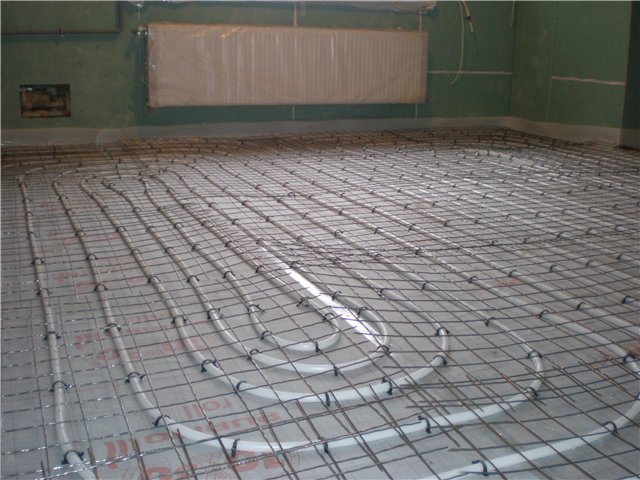
- Central heating warms the room only purposefully - the main part of the heat is concentrated in the location of the registers or other heating elements - the presence of a warm floor allows the room to warm evenly, without leaving areas with a lowered temperature.
- In the heating system there is a thermostat, by means of which you can regulate the temperature of the coolant in the pipes and, accordingly, the overall room temperature.
Minuses
- The complexity of installation - in comparison with other analogs is quite difficult to install with their own hands.
- The need to raise the common floor plane for installation - the minimum distance required for installing a heating system of this type is 100 mm.
Installation of a warm floor
Before you begin the installation of a warm floor, first of all you need to take into account the basics of designing floor heating - below you will be given the instruction + video on how to install the installation of underfloor heating yourself.
Surface preparation
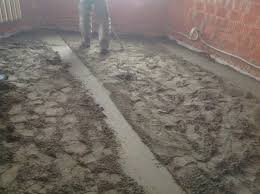
The system is installed on a pre-prepared surface - ground, PNS slabs, etc. Before installing it, you must necessarily prepare: clean from debris and align. It is necessary to remove all possible irregularities and depressions. It should be as level as possible, as it will be installed on the frame, which in turn will fall pipes.
Also on how carefully the surface will be leveled, the uniformity of heating will depend - if the height of the pipes "plays", some parts will warm up worse than others.
The simplest method of leveling is the use of a self-leveling mixture, a sufficient amount of which will make the surface almost perfectly flat. It is also possible to use a concrete screed - it will also provide a sufficient degree of leveling.
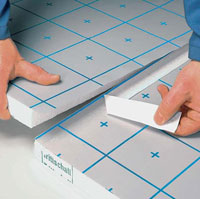
After the alignment is carried out - the surface is covered with a layer waterproofing material, which will prevent moisture from seeping. Then a layer of thermal insulation is laid, the absence of which will cause a significant loss of heat. This is due to the fact that the pipes radiate heat in all directions, including the lower part of the structure, which will absorb and dissipate it.
High-quality thermal insulation at proper packing concentrates and directs heat vertically upwards, not allowing it to dissipate. Most often as a thermal insulation foam plates are used, the thickness of which will depend on how warm you want to make the floor. The permissible thickness of the insulation varies from 30 to 150 mm.
Pipe laying
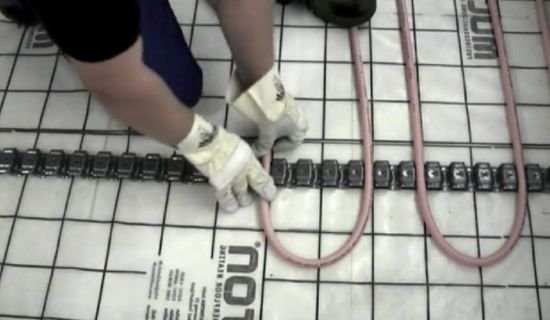
Initially, a project is being developed, according to which a pipe laying scheme will be drawn up - they can be located:
- spiral;
- snake;
- a spiral with a displaced center;
- double snake.
The type of laying is selected, based on the general geometry of the room in which the warm floor will be located. Pipes for underfloor heating are laid in steps of 80 to 300 mm from each other, depending on the desired intensity of heating.
After the general structure of the heating system has been determined, it is possible to proceed directly to laying the pipes. Previously, on the already prepared surface, a supporting frame, welded from the reinforcement, is laid, which will provide the necessary gap between the pipes and the rough floor.
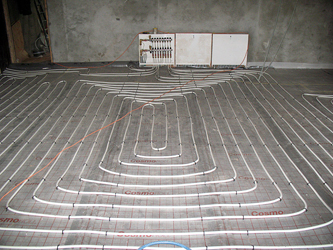
To the established reinforcing cage In the chosen sequence you get the pipes that are fixed to it using clamps. To ensure normal temperature on average per 1 sq. Km. m area should account for about 5 running meters pipes (with a step of 200 mm), and their total length should not be more than 90 m, otherwise there will be a large heat loss in the final sections of the circuit.
The more frequent arrangement of pipes compensates for heat loss. After the installation and connection is completed, the crimping process is carried out - testing the system under operating pressure, for mechanical damage and leakage.
Pouring concrete
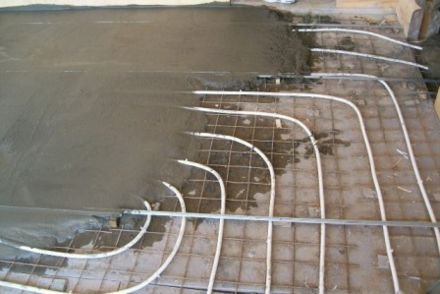
After the crimping, the screed is poured, the material for which can serve as concrete grade M300, as well as special mixtures for the installation of warm floors. The thickness of the layer should be from 40 to 70 mm. During the entire filling process, the system must necessarily be under operating pressure.
Note!
The heating can only be switched on after 26 days, that is, after the concrete solution has completely dried.
Premature incorporation can lead to surface cracking.
The result
Floor water heating will create the most comfortable temperature in the room, while not requiring any special maintenance costs. Despite the certain complexity of installation and other shortcomings - to assemble a fully operational system with your own hands will not be difficult.
